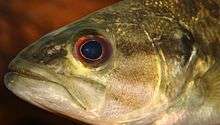Guadalupe bass
The Guadalupe bass (Micropterus treculii) is a rare species of fish endemic to the U.S. state of Texas, where it also is the official state fish. It is restricted to creeks and rivers (including the Guadalupe River, hence the name Guadalupe Bass), and is listed as Near Threatened.[2] Today, most fly fishermen and anglers practice catch-and-release techniques to improve fish populations. The Guadalupe bass is often difficult to distinguish from the smallmouth bass or spotted bass, and the fish is known to hybridize.
| Guadalupe bass | |
|---|---|
 | |
| Scientific classification | |
| Kingdom: | Animalia |
| Phylum: | Chordata |
| Class: | Actinopterygii |
| Order: | Perciformes |
| Family: | Centrarchidae |
| Genus: | Micropterus |
| Species: | M. treculii |
| Binomial name | |
| Micropterus treculii (Vaillant & Bocourt, 1874) | |
Description and range
Guadalupe bass, like most black bass, are lime to olive green in color, this particular species being lighter in shade usually in river specimens. They have a lateral line covered in mostly separate diamond shaped or circular spots, which with age fades from black to olive. There are also many smaller diamond marks scattered on the back which are less distinguished than the ones on the lateral line. Its physical traits are very similar to the spotted bass (i.e. small mouth that doesn't extend past the eye, sleek figure, etc.) with one exception: the green coloring tends to extend lower on the body past the lateral line than their cousins. So far the record is 3.71 lbs (3 lbs 11.360 oz.), caught by Dr. Bryan Townsend of Austin in 2014. The fish is only found in Edward's Plateau in central Texas. Its main habitats are the San Marcos, Colorado, Llano, and Guadalupe rivers. They can also be found in run-off creeks such as Barton Creek, Onion Creek, San Gabriel river, and The Comal river. The species has also been farm raised and stocked in the Llano river.
Threats and predators
The Guadalupe bass has almost no predators. In fact its main threat is not predation, but hybridization with the introduced smallmouth bass. The two species are very closely related and in some rivers almost half the Guadalupe Bass are hybrids. The Texas Parks and Wildlife Dept. stated it will likely stock many bass in the future to beat out the hybrid population. This will be a pilot for several other areas where rare spotted bass sub-species are having the same problems.
Habitat
Typically, Guadalupe bass are found in streams and reservoirs; they are absent from extreme headwaters. The Guadalupe Bass prefer flowing waters of streams within native variety, and use covers like large rocks, cypress trees or stumps for refuge.
Diet
The fish (especially juveniles and very old fish), unlike other bass, have an inclination towards insects. Guadalupe bass at their predatory peak prefer larger bait fish such as shad and small bass or bluegill.
Fishing
While almost unheard of elsewhere, the Guadalupe bass is very popular among fishermen in central Texas. It is cherished for its long tough fights, in which it manipulates the current and its unusually strong muscles, and beautiful colors which tend to be more natural and bright than those of spotted bass. Its preference for strong current and its large diet of insects earned it the name "Texas Brook Trout" and make it popular for fly fishermen. It fights similarly to both smallmouth bass and rainbow trout—making long runs and manipulating current, but also making sharp turns and attempting to entangle the line on structures, and even making large jumps like both species. Altogether, it makes a very satisfying fight, and it can be difficult and extremely fun to land a 2+ lb. fish.
If fishing in a larger river, one will most likely find large fish in deep pools with some current, scavenging off whatever the current brings, and in the shallows, looking for fry, bait fish, frogs, the occasional rodent, and hatching insects if in the right season. Smaller fish are found in fast current behind riffles, eating passing nymphs that were sucked in and small minnows eating the same. Due to their preference for small fish and insects, fly fishermen are at a large advantage. The IGFA all tackle world record for the species stands at 1.67kg (3lb 11oz) caught in Lake Travis in Texas in 1983.[3]
References
- NatureServe (2014). "Micropterus treculii". IUCN Red List of Threatened Species. 2014: e.T13405A19032728. doi:10.2305/IUCN.UK.2014-3.RLTS.T13405A19032728.en. Retrieved 21 May 2020.
- Gimenez Dixon, M. (1996). "Micropterus treculii". IUCN Red List of Threatened Species. 1996. Retrieved 12 June 2014.CS1 maint: ref=harv (link)
- "Bass, Guadeloupe". igfa.org. IGFA. Retrieved 17 June 2019.
Sources
- Froese, Rainer and Pauly, Daniel, eds. (2014). "Micropterus treculii" in FishBase. June 2014 version.
- "Micropterus treculii". Integrated Taxonomic Information System. Retrieved 12 June 2014.
- "Guadalupe Bass (Micropterus treculii)". Texas Parks and Wildlife Department.
